The US and the UK Master’s Part / Chapter-wise Dissertation Writing Service

Then You’ve Certainly Reached the Right place
Evidence Based Heath care
Introduction
Although research supports that incorporating evidence-based practice (EBP) promotes high-value quality of patient care and reduced costs, evidence show that standard of care has not practiced consistently by nurses (Melnyk, Fineout-Overholt, Gallagher-Ford, & Kaplan, 2012a). A long lag time continues to exist between generating research findings and their implementation in a real world setting due to innumerable barriers (Melnyk, Grossman, Chou, Mabry-Hernandez, et al., 2012) including lack of knowledge, skills, organizational culture, resistance from colleagues, and lack of EBP mentors (Melnyk et al., 2012). Yet, this essay identifies the challenges and also describes strategies for implementing an evidence-based approach to clinical nursing practice. In specific, I will reflect my challenges that I experienced personally with an acutely ill neuroscience patient with subarachnoid haemorrhage (herein referred as SAH). SAH is one of a life-threatening event that poses with a several discrete symptoms and signs making diagnosis challenging (Diringer, Bleck, Hemphill, Menon et al., 2011). Any delay in diagnosis would increase mortality and morbidity of the patients, therefore, there is a need for advanced nursing assessment and management to enhance optimum patient outcomes (Diringer et al., 2011).
Implementation of Evidence-based healthcare
There have been difficulties in defining EBP, although it broadly encloses the decisions that are taken based on scientific information, that affect the patient care. To elaborate, EBP refers to the delivery of healthcare to an individual based on scientific and clinical evidence to direct patient care and professional guidelines to delineate nurse accountability within their nursing practice (Jeffs, Beswick, Lo,Campbell, et al., 2013)(Proctor, Luke, Calhoun, McMillen, et al., 2015). Nurses especially in the field of neuroscience, are instructed to use the concepts of EBP to ensure the delivery of effective care for concerned patients. But, the issue faced here is the lack of sufficient evidence on the same, making it more taxing for the nurses to carry this forward (Connolly, Rabinstein, Carhuapoma, Derdeyn, et al., 2012). In this essay, I attempt to identify the gaps in the implementation of the principles of EBP. However, my immediate observation remains that there is a generalised deficit in support from both the organisation as well as nursing co-workers (Wallis, 2012). In addition to this I explored the why such research and literature were not considered important, mainly due to lack of resources such as access to a library or the journals themselves (Leasure, Stirlen, & Thompson, 2008) or the inability to conduct appropriate search strategies to derive such information (Obrecht, Vincent, & Ryan, 2014). In general, there also seems to be a lack of interest amongst nursing professionals towards EBP. Conversely, even those that do show some interest are bridled with several hurdles in the implementation (Stevens, 2013). This can be attributed due to several other factors such as those that are due to the organisation they work for, lack of resources or access thereof, lack of supporting environment to embrace and implement the same, and limitations in their hierarchy level like less power (Jeffs et al., 2013).
Other hurdles are related to nursing, wherein the nurses lack time, or inadequate knowledge to conduct searches or awaiting instruction from higher authorities to implement evidence-based healthcare in practice (Obrecht et al., 2014; Wallis, 2012). The main hurdle, however, remains the interpretation of the literature. This can be taken into consideration with respect to statistical interpretations. I feel that even if I crossed the hurdle of identifying appropriate references I could not interpret the findings. In conjunction with inadequate computer skills as well as limited knowledge on searching for articles further compounded the hurdles (Khammarnia, Haj Mohammadi, Amani, Rezaeian, & Setoodehzadeh, 2015).
Challenges and strategies to overcome the implementation of evidence-based healthcare practices
In this section, I would like to outline the challenges as well as measures had applied to tackle the issues of implementing EBP into nursing practice by supplicating my experience with a patient diagnosed with SAH in the neuroscience ward. To give a brief background, a 65-year old female patient with a severe headache with no associated symptoms. She also had no medical history, for 40 years (herein referred as Mrs A) she smoked half pack of cigarettes and allergic to Sulphur. Since her complaint was severe pain, through visual analogue scale (VAS), I found that her pain was at 6/10 rating (Dhakal, Hodge, Nagel, Mayes, et al., 2015) and other vital signs such as blood pressure, a temperature and respiratory rate was normal. Later, she was scanned with a non-contrast computed tomography (CT) scan, which indicated a large aneurysm in a left posterior communicating artery. She was later moved to high dependency unit (HAD) and done with four-vessel cerebral digital subtraction angiogram (DSA) (Edlow, 2008) which confirmed the carotid artery aneurysm. In this unit, it is imperative for the nurses to provide intense care for patients in acute care settings based on the data collected at different times (Connolly et al., 2012). This involves updated knowledge as to the illness areas along with critical management of the patients (Preece, 2013). However, it was observed that on return to the ward, the patient lost her memory functions which indicated the altered brain functions (Connolly et al., 2012). My seniors failed to recognize to monitor the warning signs and therefore, failed to draw conclusions which deemed important in the management of SAH (Hedlund, Ronne-Engstrom, Ekselius, & Carlsson, 2008). The other challenge was during the procedure a left anterior cerebral artery aneurysm was observed but immediate treatment could not be given. These two challenges show that either nurse may be reluctant or resistance to assess and document the patient vital signs (Cretikos, Chen, Hillman, Bellomo, et al., 2007), lack of knowledge and skills, support from the seniors despite its importance (Jeffs et al., 2013) Although the case looks so simple, but as a nurse, I faced several challenges at pre-, and post-operative procedures. I was initially asked by a physician to conduct neurological observations using the Glasgow coma scale (GCS) (Wang & Heros, 2015) but since I was not trained, I could not fill the form even my peer and senior nurses were not cooperative enough to train me. Further, Mrs. A was felt nervous due to the uncertainty of her condition but initially as nurses we were embarrassed with the situation and crowded the room, but I remember reading that SAH patients need a quite environment and patient should be kept calm, therefore after consulting with the senior physician, and given adequate analgesia to decrease surges in the stress and blood pressure. Mrs. A could able to recover quickly, due to proactive response and a quick diagnosis of an aneurysm. However, that in turn created resistance among other nurses especially senior nurses which showed that there is a need for training that incorporates the change in attitude, skill and knowledge. Further to this, issues arise largely due to lack of mentors, a generalised lack of knowledge and also organisational environment (Jeffs et al., 2013; Obrecht et al., 2014; Shifaza, Evans, & Bradley, 2014; Hughes, 2008).
In order to conquer such drawbacks, it becomes necessary to inculcate an organisational environment that embraces EBP especially in magnet hospitals where I had been posted. It has already been deemed that strong leadership can lead to better staff performance ultimately resulting in better patient outcomes (Mick & Mark, 2005). This is so that nursing excellence can be achieved especially in an acute care setting such as the high dependency unit.
With respect to my experience in the neuroscience ward, there were many inconsistencies that occurred. For instance, the relatives of the patient as well as the patient herself were under high psychological trauma after the diagnosis of SAH. It has been deemed most recently that it is necessary to have an interdisciplinary approach involving psychological professionals to help both the family as well as the patient (Modisett, Koyfman, & Runyon, 2014). In this case, the relatives were not counselled by the nurses or by the team in any way. The lax attitude toward the lack of updating based on recent evidence stems from the nursing leaders and the organisational drawbacks in identifying the importance of EBP. Therefore, there is a need for incorporation of EBP at all levels of practices such as rounds, education and the evaluation of the patient outcomes (Leasure et al., 2008).
Conclusion
From this essay coupled with my experience in the neuroscience ward, I have identified that nurse leadership and lack of organisational support and non-cooperation from my nursing colleagues along with inadequate skills for search literature have prevented me from implementing EBP in daily nursing practice. The nurses in my ward showed resistance as well as a lack of time. The lack of time may be attributed to the understaffing issues in the neuroscience department. There was also much resistance from the nurse leaders and the management towards following EBP. To draw from my experience again, several factors such as delay in placing the venous cannula could have been avoided. This stemmed from the lack of awareness that timely cannula placement is imperative in cases of SAH. Using EBP, the competency of the nurses can be increased in this regard and even if the doctor is not available patient care need not be compromised. But this can only be achieved if the nurses are allowed to use and provided with updated information on the same. I also observed that students at the graduate level had negative feelings. A viable solution may be to introduce EBP concepts at an academic level and also pairing student nurses with trained nurses is to perform along with their peers, leaders and clinicians (especially those who resist). This can help reduce variability in care for the patient. For cases of SAH, managing the patients and relatives, placing venous cannulas and monitoring the patient frequently for fluid output, orientation and vitals constitute to patient outcomes. I hence conclude from this essay that nurse practitioners are to adopt the use of literature, and critically evaluate such evidence to translate into daily practice so that knowledge of management and clarity if their role will enhance nursing care in acute care settings of high dependency units in neuroscience department.
Part B
A. Clinical Research Questions,
- 1. What is the current level of knowledge and attitude that nurses hold about dementia in residential care homes
- 2. PICO table
- a. Type of Patients
- b. Intervention
- c. Comparison Intervention
- d. Outcome
| Type of patients or problem | Intervention | Comparison Intervention | Outcome |
|---|---|---|---|
| Patients with dementia in residential care | Training and Education | No training and education | Level of knowledge , attitude and improvement in care for patients |
| Keywords | Keywords | Keywords | Keywords |
| dementia, cognitive impairment, nurse care dementia residential care dementia | intervention, education and training nurse care dementia, nurse training dementia, nurse education dementia | intervention, education and training nurse care dementia, nurse training dementia, nurse education dementia | knowledge level care in dementia, attitude for dementia care, improved dementia care |
Step 2
Using the keywords, search terms identified
Google scholar

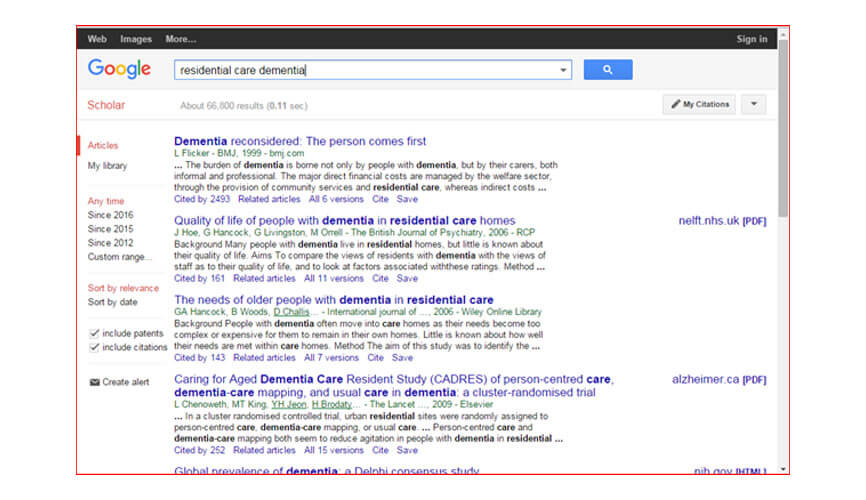
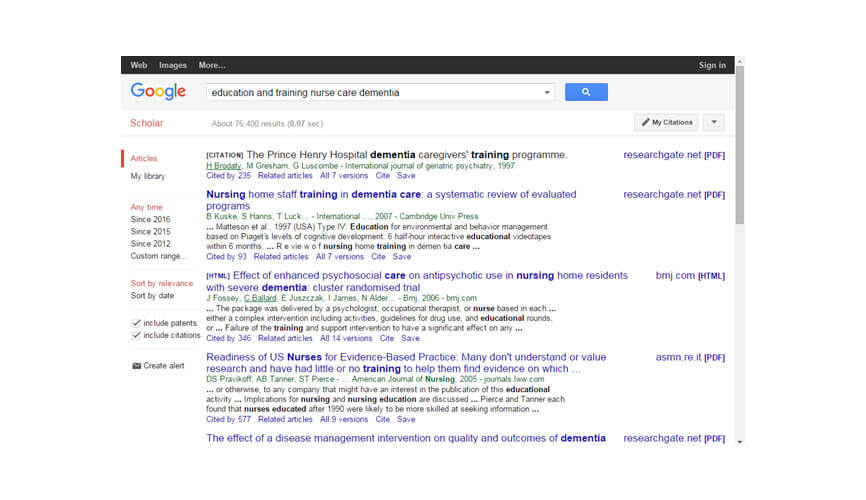
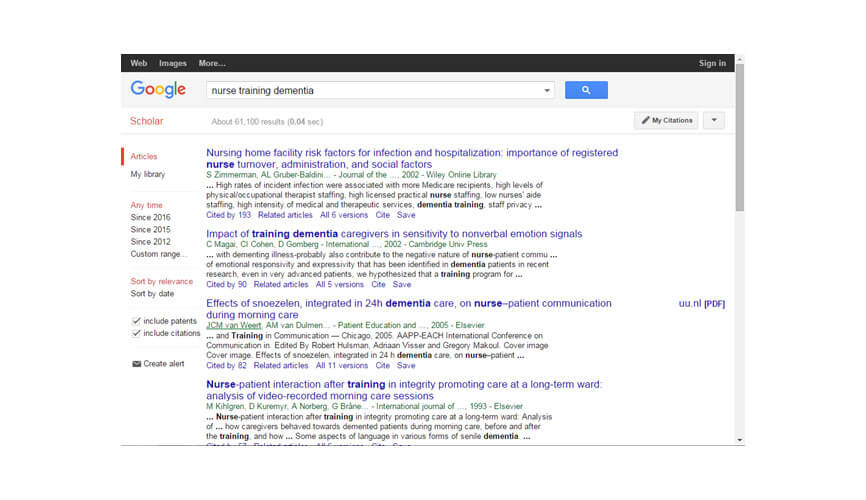
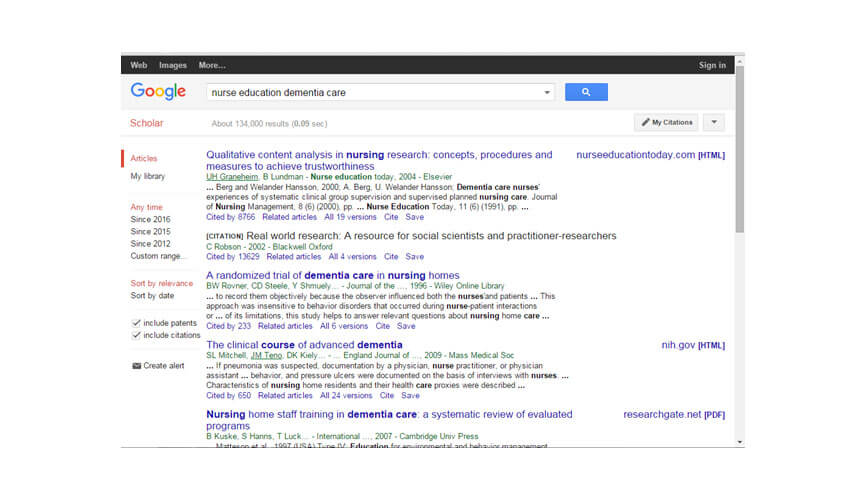
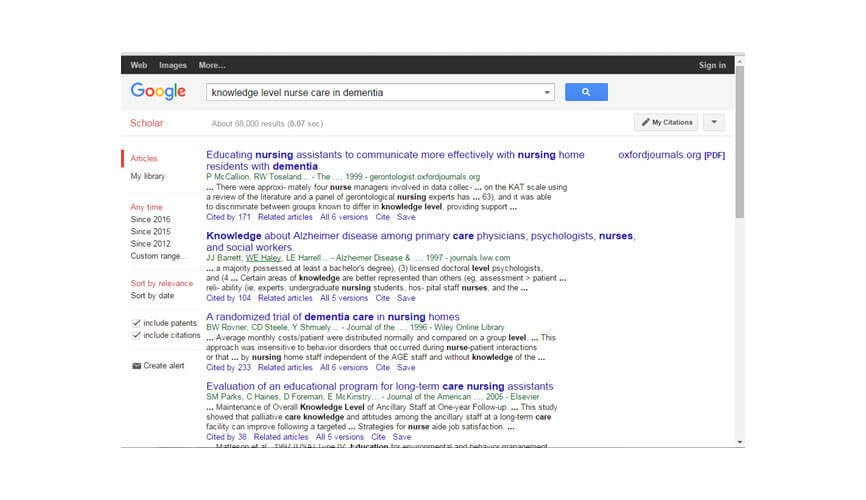
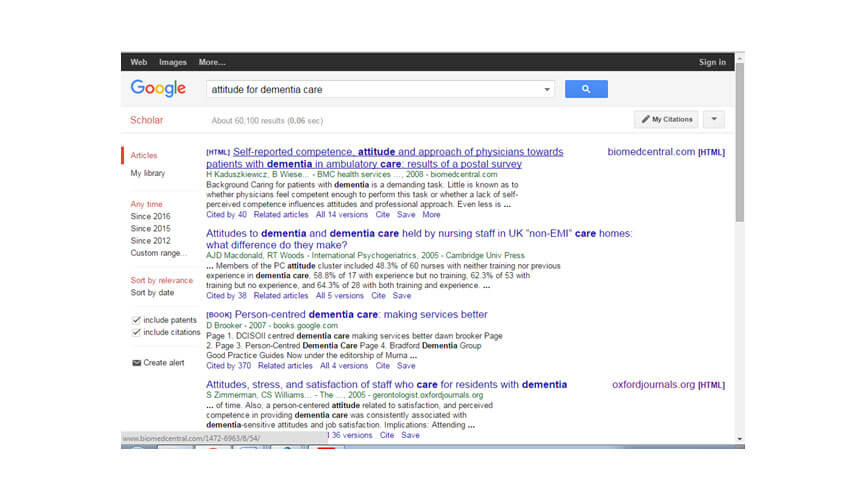
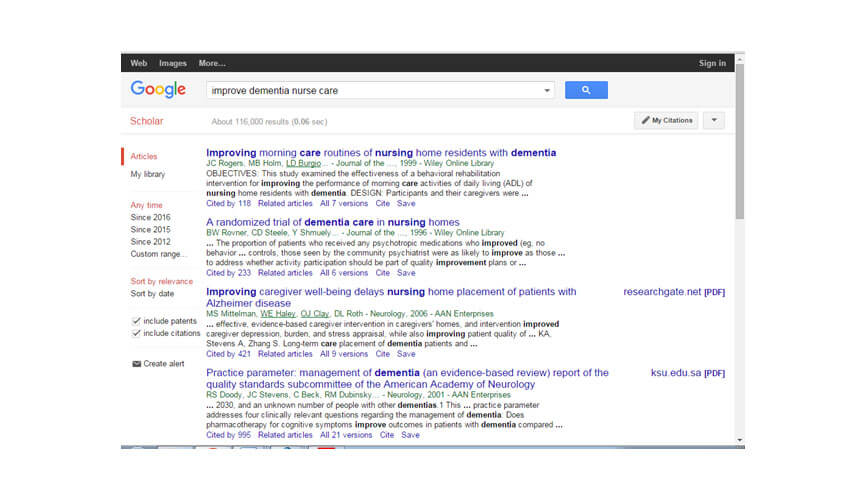
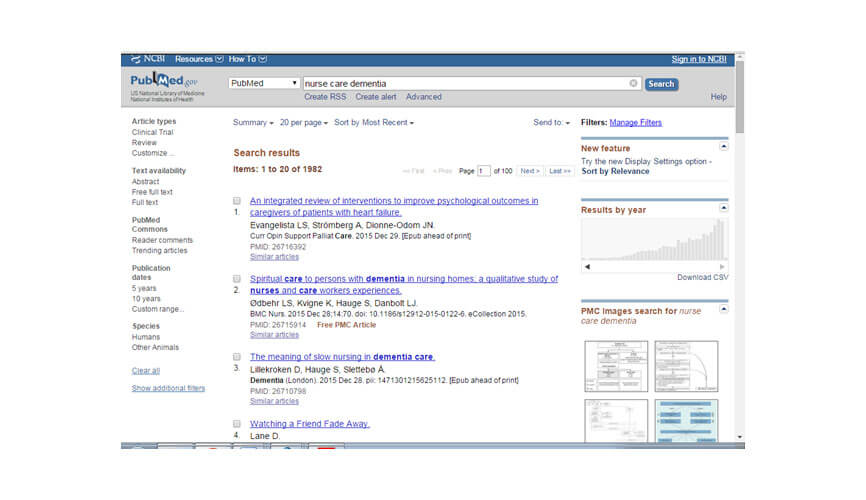
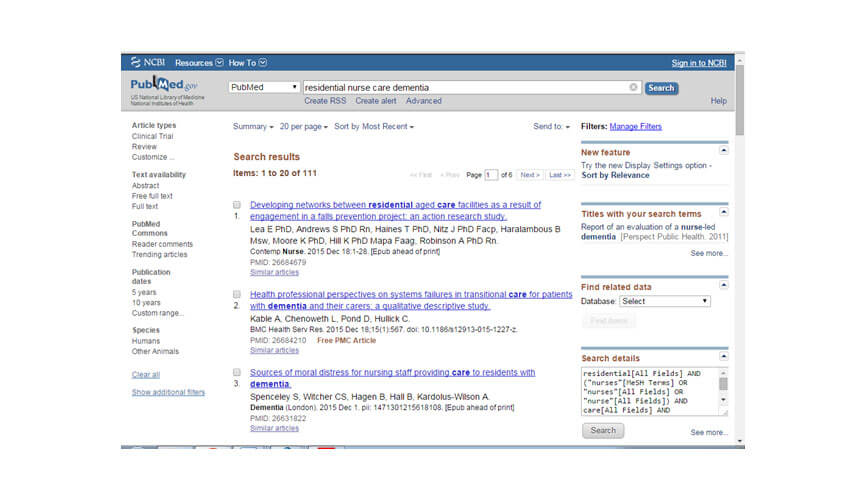
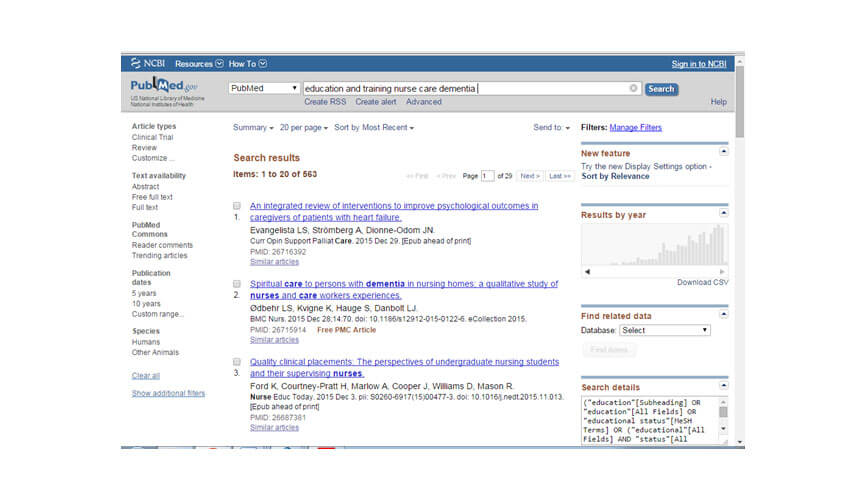
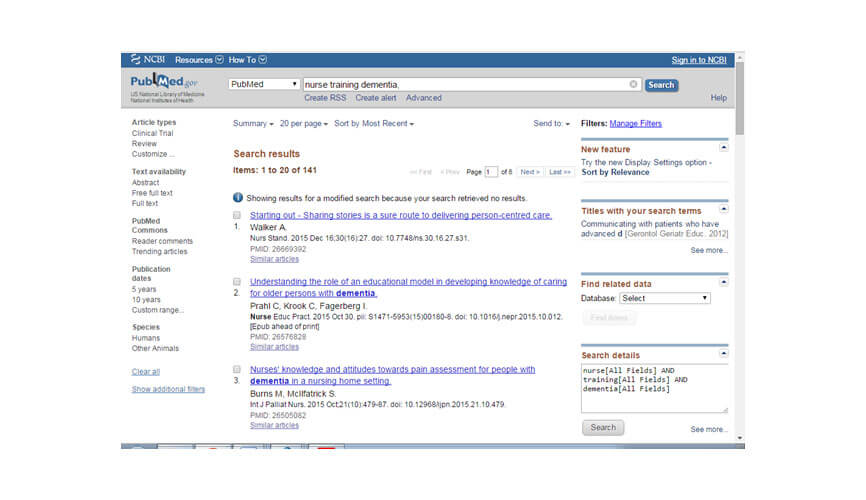
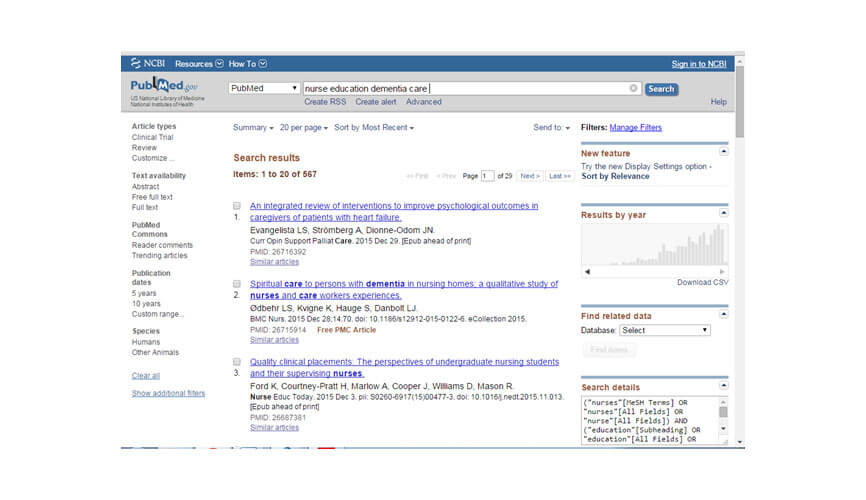
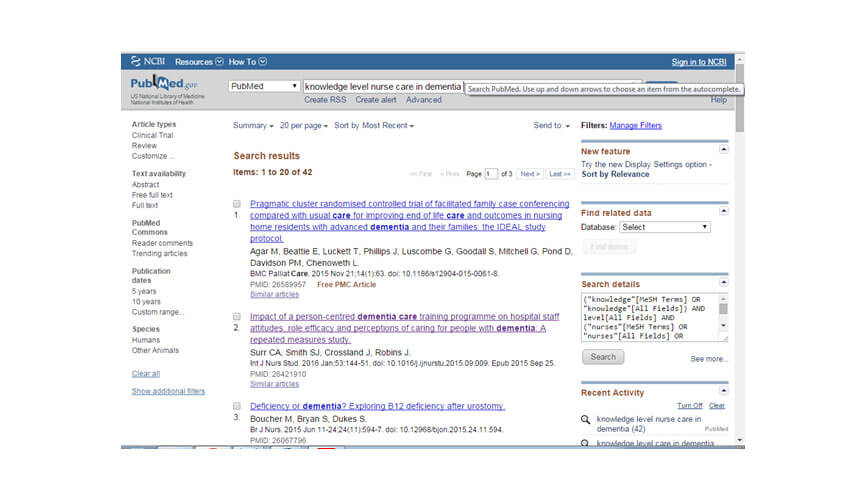
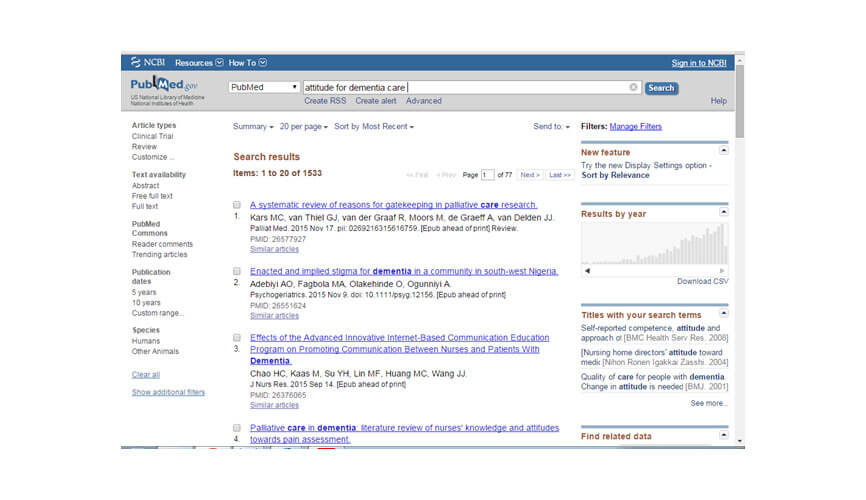
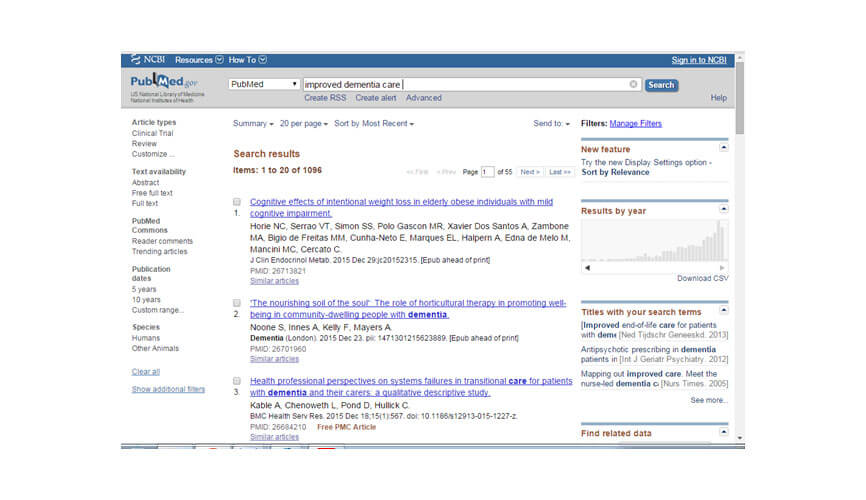
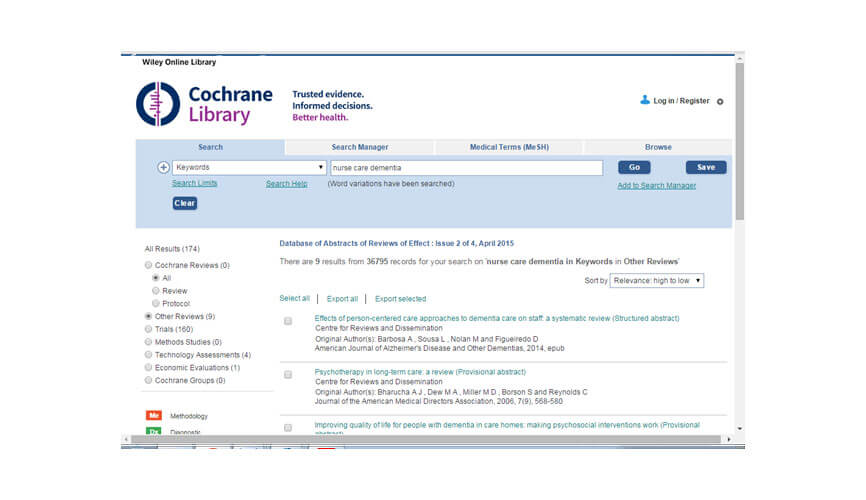
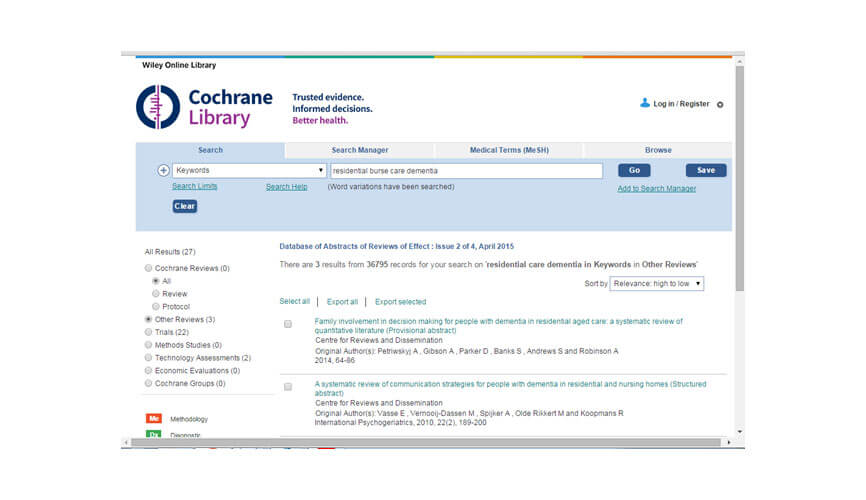
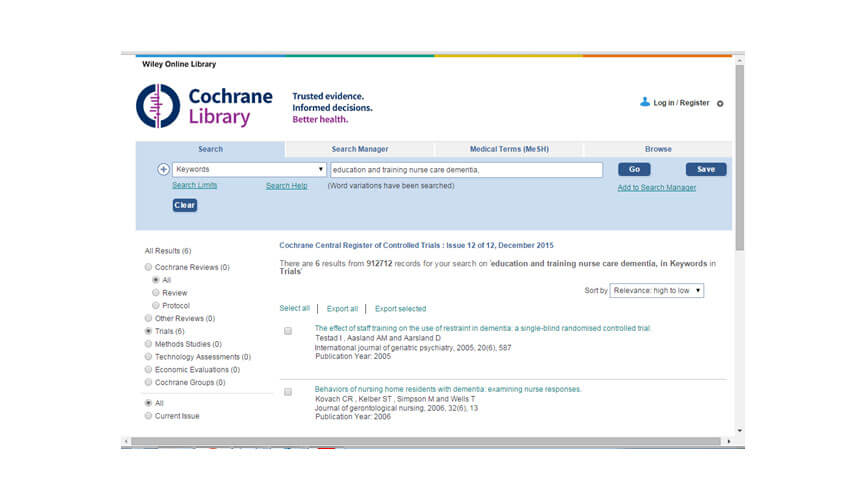
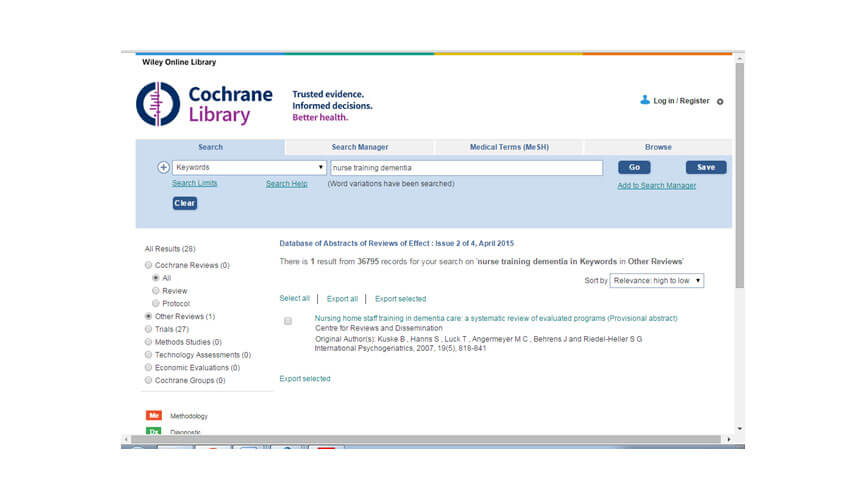
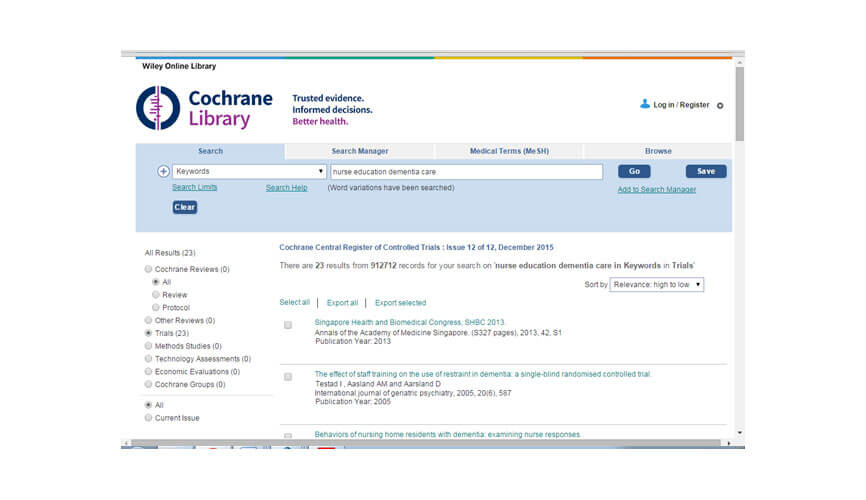
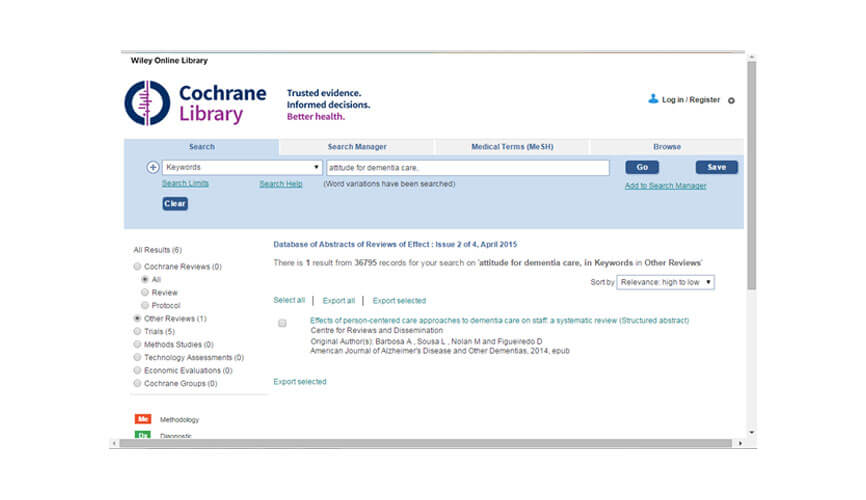
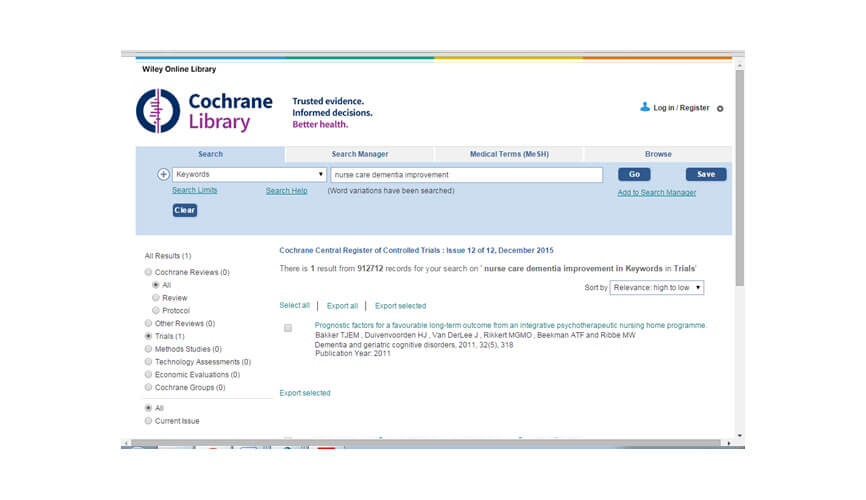
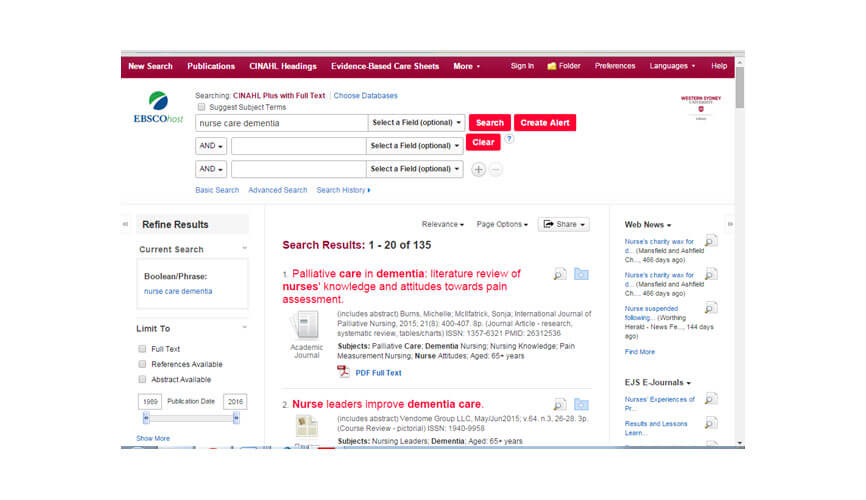
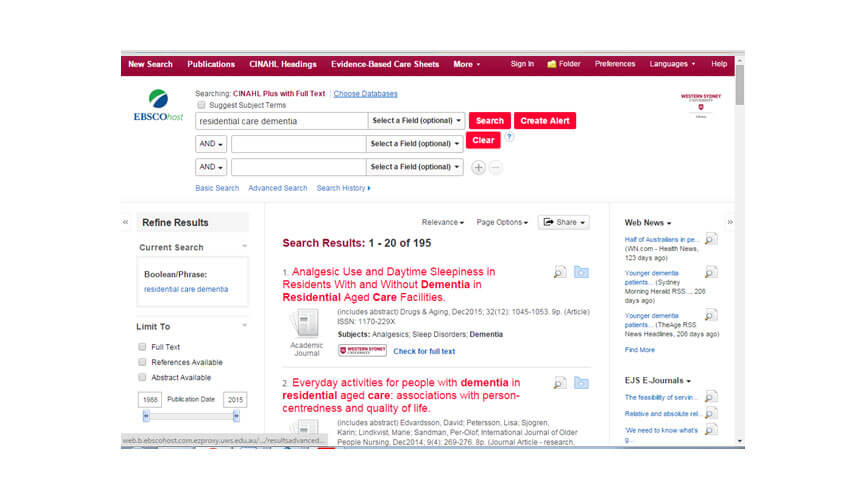
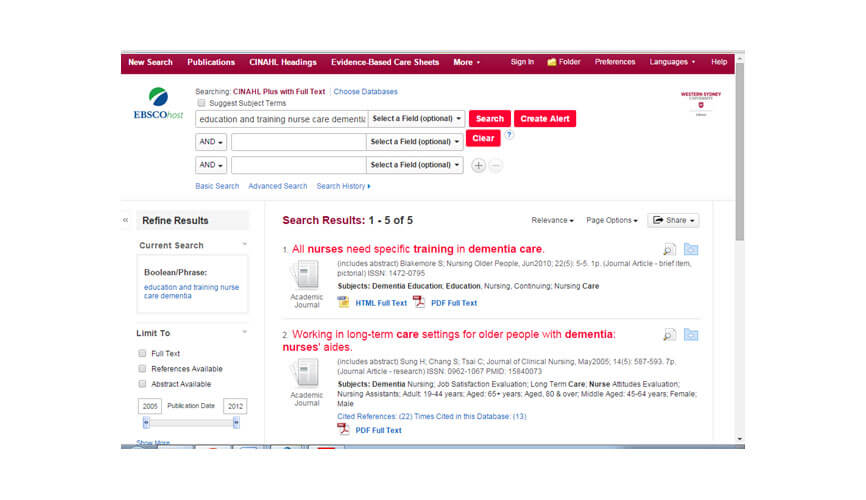
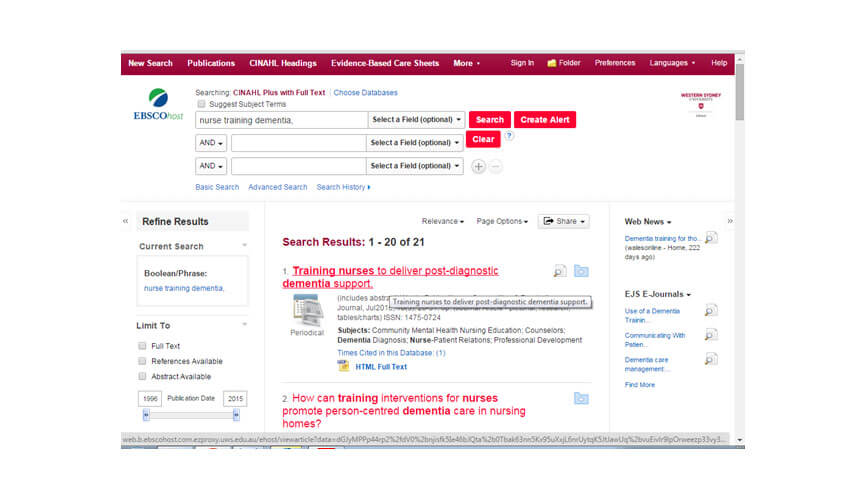
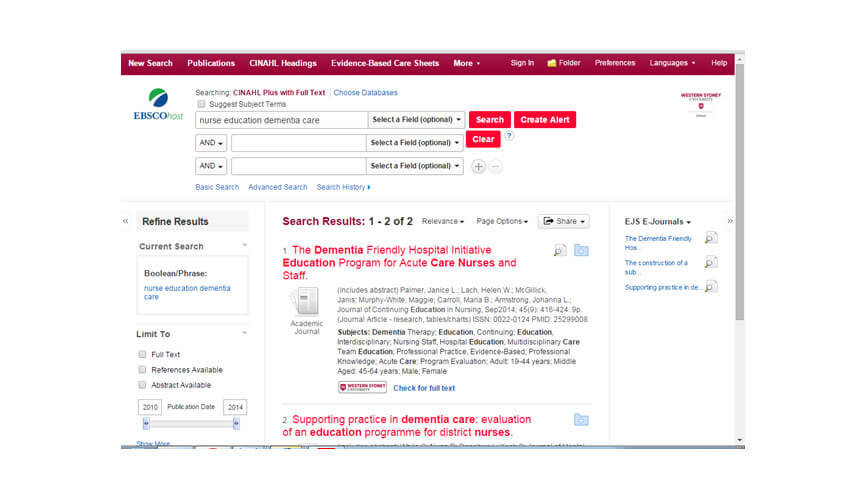
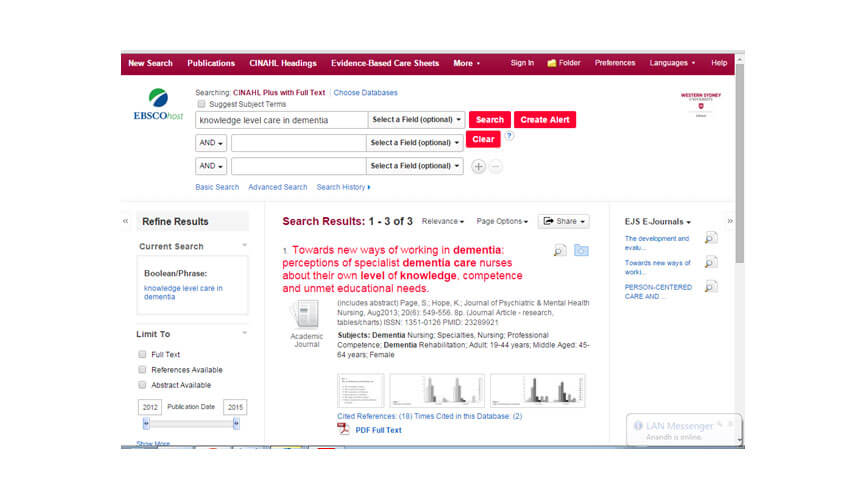
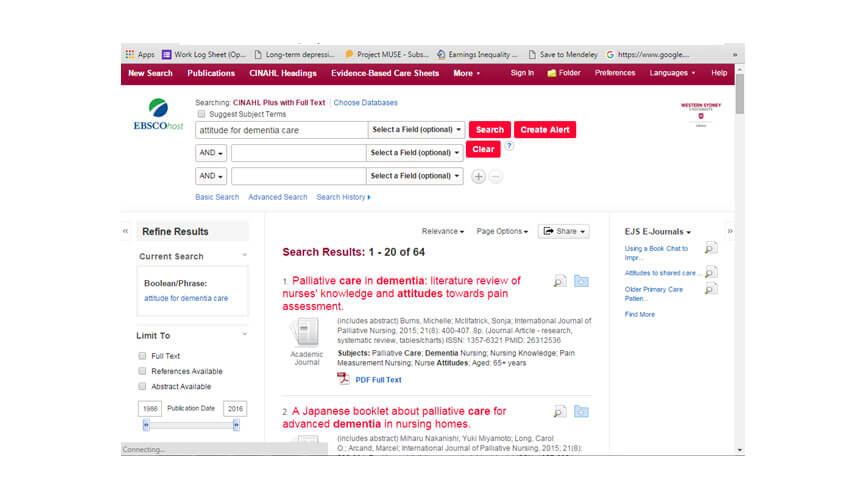
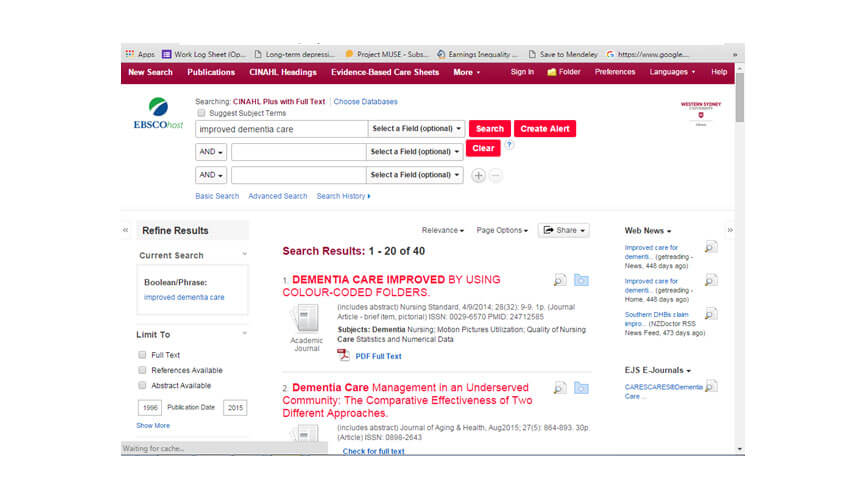
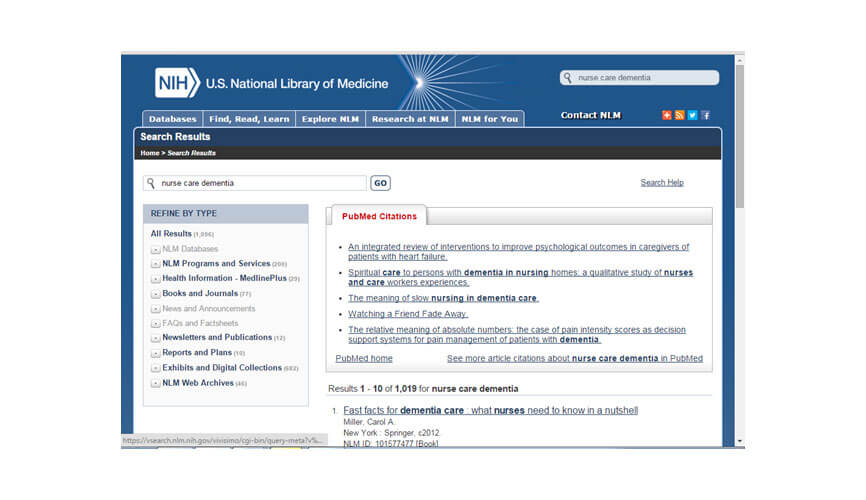
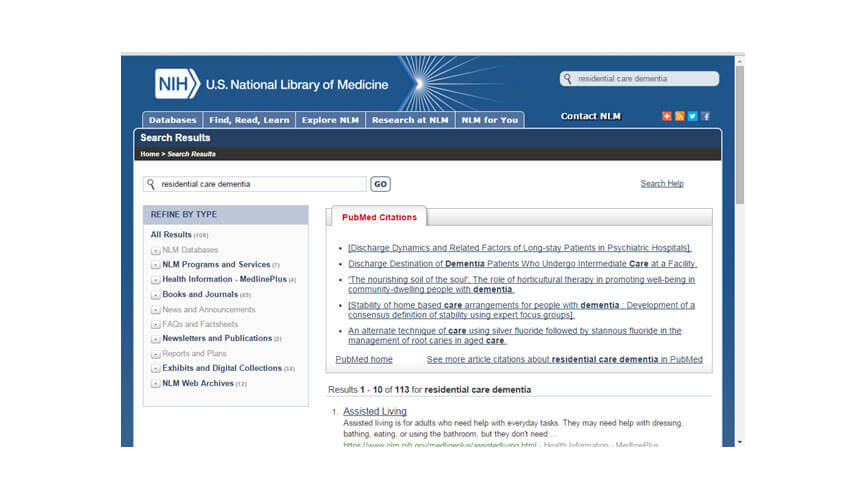
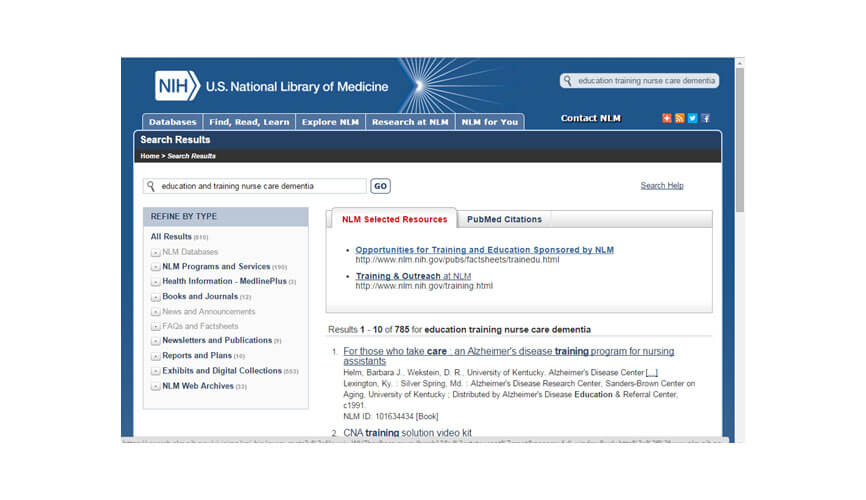
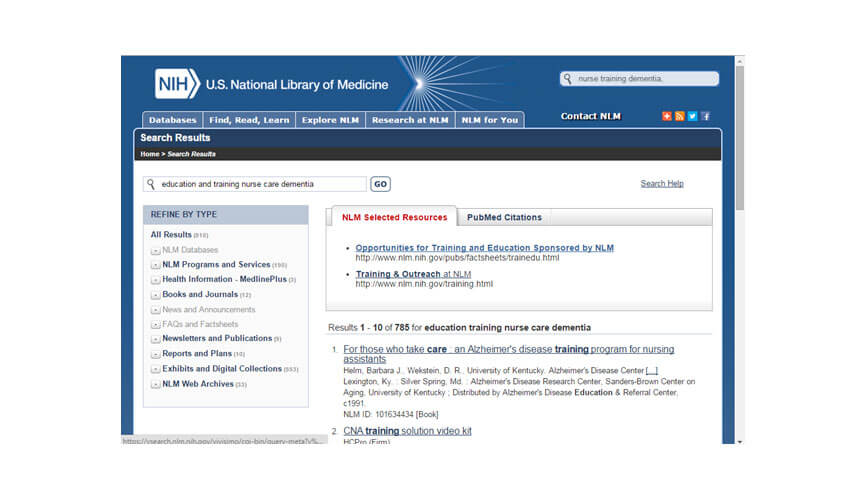
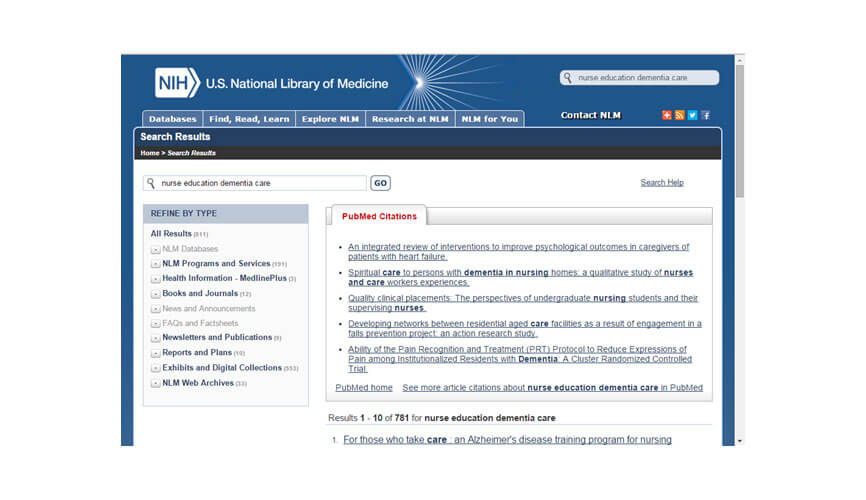
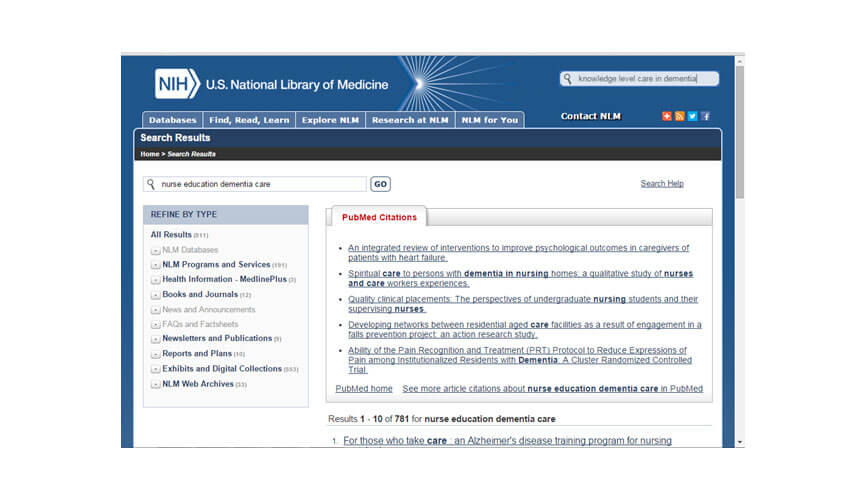
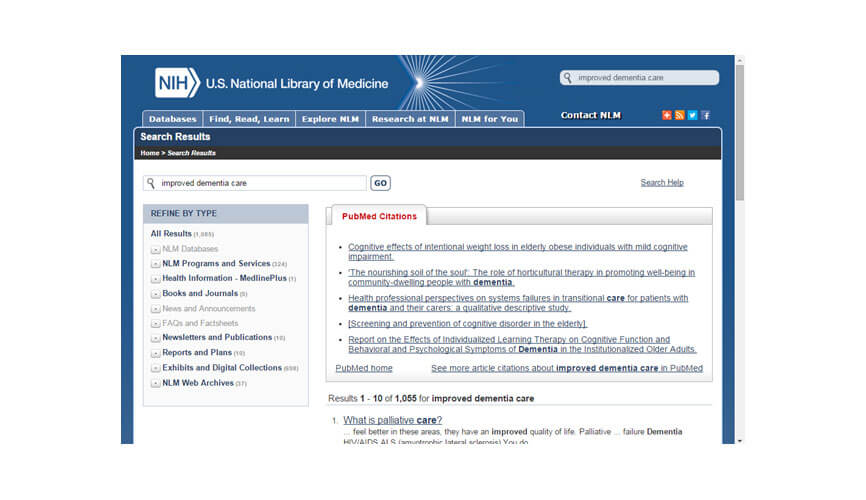
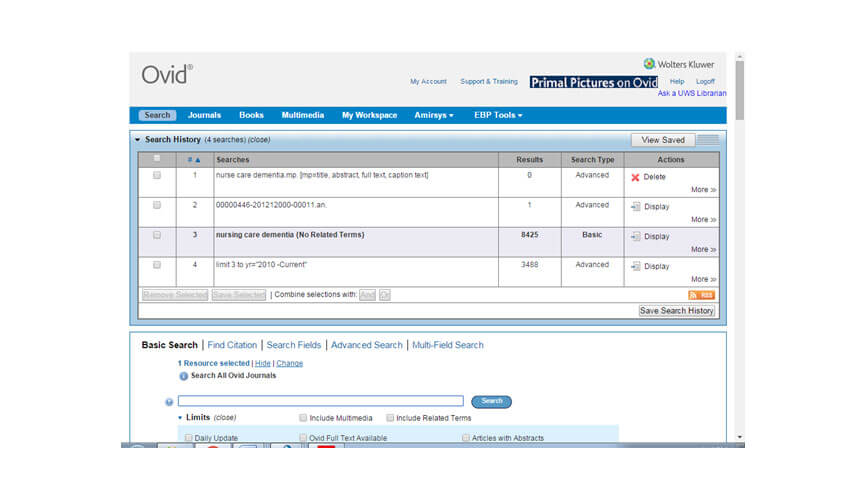
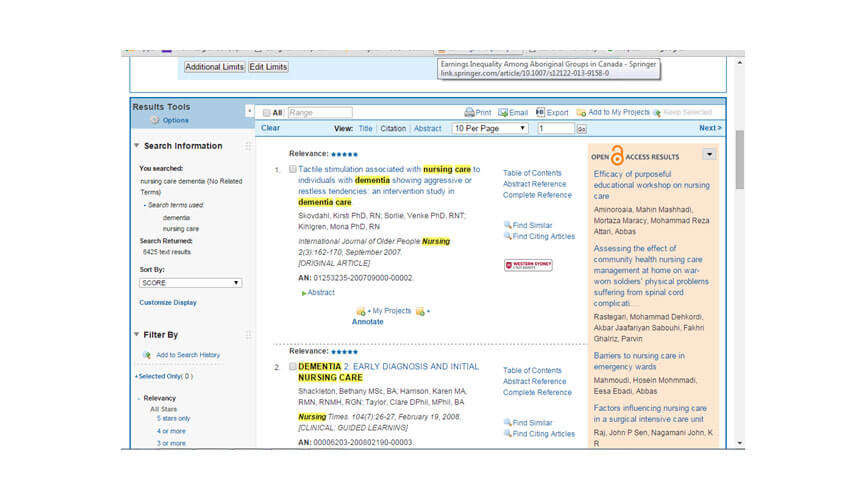
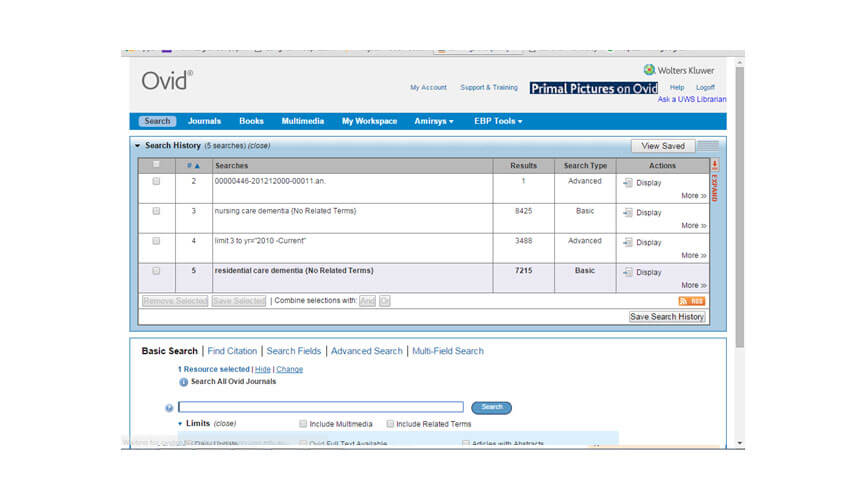
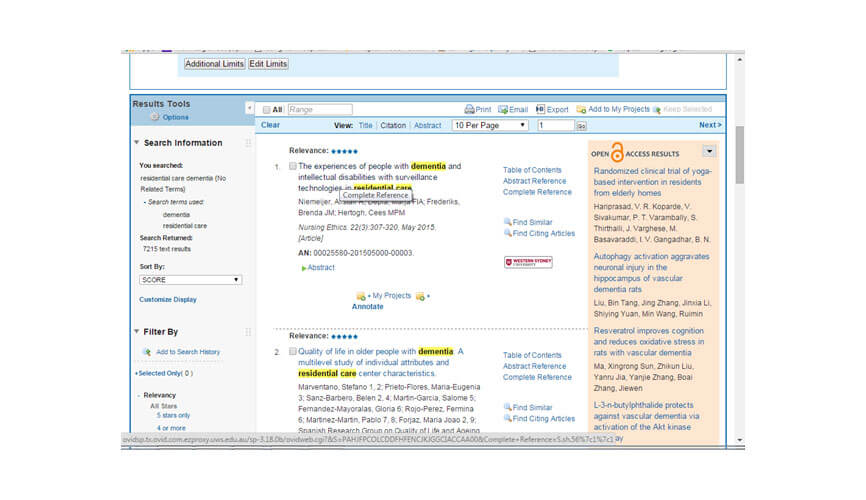
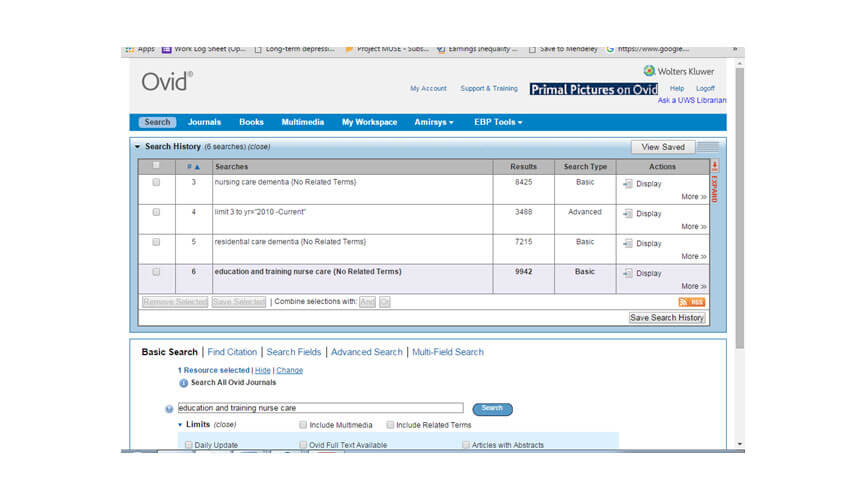
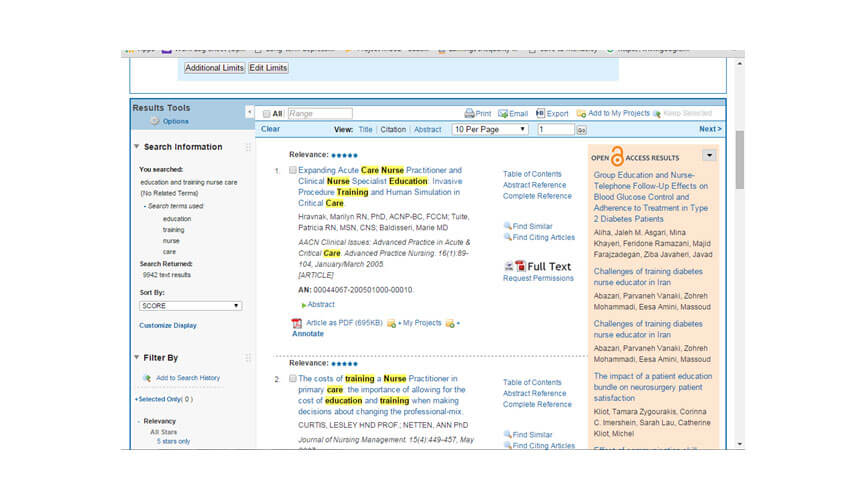
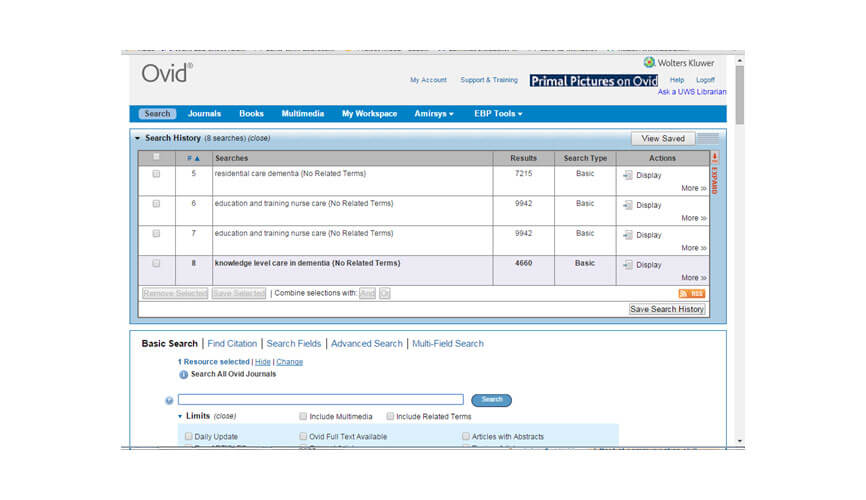
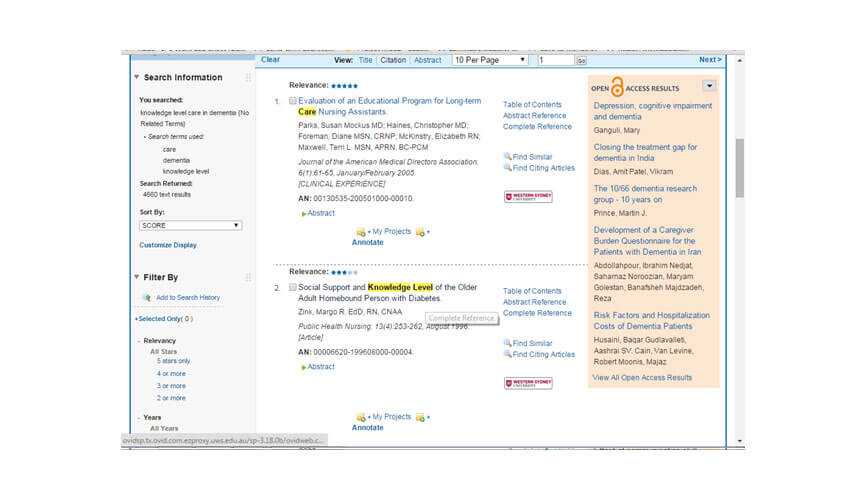
| S.No | Database | Keywords | No. of hits |
|---|---|---|---|
| 1 | Google Scholar | nurse care dementia residential care dementiaeducation and training nurse care dementia, nurse training dementia, nurse education dementia care knowledge level care in dementia, attitude for dementia care, improved dementia care | 425 |
| 2 | PubMed | nurse care dementia residential care dementia education and training nurse care dementia, nurse training dementia, nurse education dementia care knowledge level care in dementia, attitude for dementia care, improved dementia care | 64 |
| 3 | Cochrane library | nurse care dementia residential care dementia education and training nurse care dementia, nurse training dementia, nurse education dementia care knowledge level care in dementia, attitude for dementia care, improved dementia care | 15 |
| 4 | NIH | nurse care dementia residential care dementia education and training nurse care dementia, nurse training dementia, nurse education dementia care knowledge level care in dementia, attitude for dementia care, improved dementia care | 367 |
| 5 | CINAHL | nurse care dementia residential care dementia education and training nurse care dementia, nurse training dementia, nurse education dementia care knowledge level care in dementia, attitude for dementia care, improved dementia care | 48 |
| 6 | OVID | nurse care dementia residential care dementia education and training nurse care knowledge level care in dementia, attitude for dementia care, | 565 |
ARTICLE IDENTIFIED
Attitudes, Stress, and Satisfaction of Staff Who Care for Residents With Dementia (Zimmerman, Williams, Reed, Boustani, et al., 2005)
| Type of patients or problem | Intervention | Comparison Intervention | Outcome |
|---|---|---|---|
| Patients with dementia in residential long term care | Training | No training | Level of attitude, stress level and level of satisfaction of staff in residents with dementia |

Researchers to mentor-We write your Assignments & Dissertation
With our team of researchers & Statisticians - Tutors India guarantees your grade & acceptance!
About serviceReference
Connolly, E. S., Rabinstein, A. A., Carhuapoma, J. R., Derdeyn, C. P., Dion, J., Higashida, R. T., … Vespa, P. (2012). Guidelines for the Management of Aneurysmal Subarachnoid Hemorrhage: A Guideline for Healthcare Professionals From the American Heart Association/American Stroke Association. Stroke, 43(6), 1711–1737. Doi:10.1161/STR.0b013e3182587839
Cretikos, M., Chen, J., Hillman, K., Bellomo, R., Finfer, S., & Flabouris, A. (2007). The objective medical emergency team activation criteria. A Case-Control Study. Resuscitation, 73(1), 62–72.
Dhakal, L. P., Hodge, D. O., Nagel, J., Nagal, J., Mayes, M., Richie, A., Freeman, W. D. (2015). Safety and tolerability of gabapentin for aneurysmal subarachnoid hemorrhage (sah) headache and meningismus. Neurocritical Care, 22(3), 414–21. doi: 10.1007/s12028-014-0086-5
Diringer, M. N., Bleck, T. P., Claude Hemphill, J., Menon, D., Shutter, L., Vespa, P., … Zipfel, G. (2011). Critical Care Management of Patients Following Aneurysmal Subarachnoid Hemorrhage: Recommendations from the Neurocritical Care Society’s Multidisciplinary Consensus Conference. Neurocritical Care, 15(2), 211–240. doi: 10.1007/s12028-011-9605-9
Hedlund, M., Ronne-Engstrom, E., Ekselius, L., & Carlsson, M. (2008). From monitoring physiological functions to using psychological strategies. Nurses’ view of caring for the aneurysmal subarachnoid haemorrhage patient. Journal of Clinical Nursing, 17(3), 403–11. doi: 10.1111/j.1365-2702.2006.01878.x
Edlow, J. A. (2008). Diagnosing headache in the emergency department: what is more important? Being right, or not being wrong? European Journal of Neurology, 15(12), 1257–1258. doi: 10.1111/j.1468-1331.2008.02280.x
Hsu, L.L., Chang, W.H. & Hsieh. S.I. (2015). The effects of Scenario-based simulation course training on nurses communication competence and self-efficacy: A Randomized controlled trial. Journal of Professional Nursing, 31 (1), 37-49. doi: 10.1016/j.profnurs.2014.05.007
Hughes, R. G. (2008). Patient Safety and Quality: An Evidence-Based Handbook for Nurses. Rockville, MD: Agency for Healthcare Research and Quality. Retrieved from http://archive.ahrq.gov/professionals/clinicians-providers/resources/nursing/resources/nurseshdbk/nurseshdbk.pdf
Jeffs, L., Beswick, S., Lo, J., Campbell, H., Ferris, E., & Sidani, S. (2013). Defining What Evidence is, Linking It to Patient Outcomes, and Making It Relevant to Practice: Insight from Clinical Nurses. Applied Nursing Research, 26(3), 105–109. doi: 10.1016/j.apnr.2013.03.002
Khammarnia, M., Haj Mohammadi, M., Amani, Z., Rezaeian, S., & Setoodehzadeh, F. (2015). Barriers to Implementation of Evidence Based Practice in Zahedan Teaching Hospitals, Iran, 2014. Nursing Research and Practice, 2015, 1–5. doi: 10.1155/2015/357140
Leasure, A. R., Stirlen, J., & Thompson, C. (2008). Barriers and facilitators to the use of evidence-based best practices. Dimensions of Critical Care Nursing : DCCN, 27(2), 74–82; quiz 83–4. Retrieved from http://www.ncbi.nlm.nih.gov/pubmed/18510185
Melnyk, B. M., Fineout-Overholt, E., Gallagher-Ford, L., & Kaplan, L. (2012). The state of evidence-based practice in US nurses: critical implications for nurse leaders and educators. The Journal of Nursing Administration, 42(9), 410–7. doi: 10.1097/NNA.0b013e3182664e0a
Melnyk, B. M., Grossman, D. C., Chou, R., Mabry-Hernandez, I., Nicholson, W., DeWitt, T. G., … Flores, G. (2012). USPSTF Perspective on Evidence-Based Preventive Recommendations for Children. Pediatrics, 130(2), 399–407. doi: 10.1542/peds.2011-2087
Mick, S. S., & Mark, B. A. (2005). The contribution of organization theory to nursing health services research. Nursing Outlook, 53(6), 317–323. doi: 10.1016/j.outlook.2005.07.002
Modisett, K. L., Koyfman, A., & Runyon, M. S. (2014). The diagnosis of and emergent care for the patient with subarachnoid haemorrhage in resource-limited settings. African Journal of Emergency Medicine, 4(3), 140–149. doi: 10.1016/j.afjem.2014.04.002
Obrecht, J. A., Van Hulle Vincent, C., & Ryan, C. S. (2014). Implementation of Evidence-Based Practice for a Pediatric Pain Assessment Instrument. Clinical Nurse Specialist, 28(2), 97–104. doi: 10.1097/NUR.0000000000000032
Preece, A. (2013). Neuroscience Safe Staffing Benchmark Statements. Retrieved from http://uir.ulster.ac.uk/27997/1/Neuroscience_Safe_Staffing_Benchmark_Statements_Final_Oct_2013.pdf
Proctor, E., Luke, D., Calhoun, A., McMillen, C., Brownson, R., McCrary, S., & Padek, M. (2015). Sustainability of evidence-based healthcare: research agenda, methodological advances, and infrastructure support. Implementation Science, 10(1), 88-93. doi: 10.1186/s13012-015-0274-5
Shifaza, F., Evans, D., & Bradley, H. (2014). Nurses’ Perceptions of Barriers and Facilitators to Implement EBP in the Maldives. Advances in Nursing, 2014, 1–7. doi: 10.1155/2014/698604
Stevens, K. R. (2013). The Impact of Evidence-Based Practice in Nursing and the Next Big Ideas. The Online Journal of Issues in Nursing, 13(8), 4-12. Retrieved from http://www.ncbi.nlm.nih.gov/pubmed/23758422
Wallis, L. (2012). Barriers to Implementing Evidence-Based Practice Remain High for U.S. Nurses. AJN, American Journal of Nursing, 112(12), 15. doi: 10.1097/01.NAJ.0000423491.98489.70
Stevens, K. R. (2013). The Impact of Evidence-Based Practice in Nursing and the Next Big Ideas. The Online Journal of Issues in Nursing, 13(8), 4-12. Retrieved from http://www.ncbi.nlm.nih.gov/pubmed/23758422
Wallis, L. (2012). Barriers to Implementing Evidence-Based Practice Remain High for U.S. Nurses. AJN, American Journal of Nursing, 112(12), 15. doi: 10.1097/01.NAJ.0000423491.98489.70
Wang, A. C., & Heros, R. C. (2015). Editorial: Subarachnoid hemorrhage grading scales. Journal of Neurosurgery, 1–3. Doi:10.3171/2015.3.JNS15336
Zimmerman, S., Williams, C. S., Reed, P. S., Boustani, M., Preisser, J. S., Heck, E. ve Sloane, P. D. (2005). Attitudes, Stress, and Satisfaction of Staff Who Care for Residents with Dementia. The Gerontologist, 45(Supplement 1), 96–105. doi: 10.1093/geront/45.suppl_1.96

Full Fledged Academic Writing & Editing services
Original and high-standard Content
Plagiarism free document
Fully referenced with high quality peer reviewed journals & textbooks
On-time delivery
Unlimited Revisions
On call /in-person brainstorming session
More From TutorsIndia
Coursework Index Dissertation Index Dissertation Proposal Research Methodologies Literature Review Manuscript DevelopmentREQUEST REMOVAL


